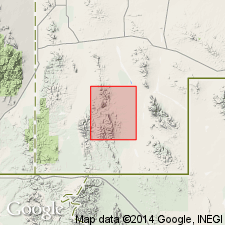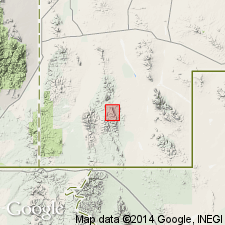
- Usage in publication:
-
- Gillespie Tuff
- Modifications:
-
- Mapped
- Dominant lithology:
-
- Tuff
- AAPG geologic province:
-
- Pedregosa basin
Summary:
Gillespie Tuff. Pink, welded, quartz latite tuff. Formation generally thick, uniform in composition and texture throughout, well indurated, and commonly exposed in bold columnar-jointed cliffs. Underlies Center Peak Latite (new); overlies Walnut Wells Monzonite and Animas Monzonite (new). Age is Tertiary.
Source: US geologic names lexicon (USGS Bull. 1350, p. 289).

- Usage in publication:
-
- Gillespie Tuff
- Modifications:
-
- Principal reference
- Dominant lithology:
-
- Tuff
- Quartz latite
- AAPG geologic province:
-
- Pedregosa basin
Summary:
Pg. 50-52, pl. 1. Gillespie Tuff. Quartz latite composition. Thickness more than 1,500 feet. Rests with apparent conformity upon Cedar Hill Andesite (new) from Cowboy Spring area northward; to south lies with apparent conformity upon Bluff Creek Formation (new). In southern part of quadrangle, formation overlain unconformably by unit of well-bedded sandstone and breccia about 30 feet thick. Above this unit is Center Peak Latite. In northern part of quadrangle, unconformably underlies Park Tuff. Age is Tertiary.
Named from exposures on Gillespie Mountain, in sec. 33, T. 30 S., R. 18 W., Walnut Wells quadrangle, Hidalgo Co., southwestern NM. Most prominent and widespread volcanic unit in Walnut Wells quadrangle. Extends into northern Mexico.
Source: Publication; US geologic names lexicon (USGS Bull. 1350, p. 289).

- Usage in publication:
-
- Gillespie Tuff
- Modifications:
-
- Age modified
- AAPG geologic province:
-
- Pedregosa basin
Summary:
Age modified from Tertiary to Oligocene on basis of a K-Ar biotite date of 32.1 +/-0.7 Ma and of 32.9 +/-0.7 Ma. The latter date obtained from an unpublished thesis. Underlies a major part of the wilderness area which lies in the Pedregosa basin. Geologic map.
Source: GNU records (USGS DDS-6; Denver GNULEX).
For more information, please contact Nancy Stamm, Geologic Names Committee Secretary.
Asterisk (*) indicates published by U.S. Geological Survey authors.
"No current usage" (†) implies that a name has been abandoned or has fallen into disuse. Former usage and, if known, replacement name given in parentheses ( ).
Slash (/) indicates name conflicts with nomenclatural guidelines (CSN, 1933; ACSN, 1961, 1970; NACSN, 1983, 2005, 2021). May be explained within brackets ([ ]).

